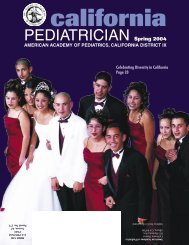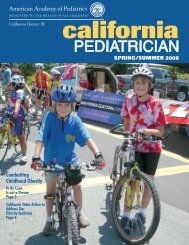PEDIATRICIAN Spring 2003 - AAP-CA
PEDIATRICIAN Spring 2003 - AAP-CA
PEDIATRICIAN Spring 2003 - AAP-CA
You also want an ePaper? Increase the reach of your titles
YUMPU automatically turns print PDFs into web optimized ePapers that Google loves.
Twenty-Five Years of Home Mechanical<br />
Ventilation in Children:<br />
The Program at Childrens Hospital Los Angeles<br />
Manisha Witmans, M.D., Sheila S. Kun, R.N., M.S., and Thomas G. Keens, M.D.<br />
Braun introduced the idea of mechanical<br />
ventilation in 1889 and by the<br />
mid 1940s hospitals were able to<br />
care for adults with respiratory failure with<br />
large ventilators called “iron lungs.” The technology<br />
has continued to evolve from a large,<br />
intrusive hospital based system to a lighter,<br />
portable system that allows families to care for<br />
medically complicated patients at home.<br />
Home mechanical ventilation has<br />
changed tremendously in the last 25 years.<br />
The home mechanical ventilation program at<br />
Childrens Hospital Los Angeles (CHLA) is<br />
an example of what is achievable in children<br />
with chronic respiratory failure who require<br />
mechanical ventilation. Since the inception<br />
of the home ventilator program in 1977, the<br />
CHLA program has grown to include over 375<br />
children who are followed for home mechanical<br />
ventilation. The program children requiring<br />
assisted mechanical ventilation have ventilatory<br />
muscle weakness (45%), chronic lung disease<br />
(hypoplastic lungs and chest wall defects)<br />
(26%) and central hypoventilation syndromes<br />
(29%). The CHLA program is unique in that<br />
there is a large number of small infants with<br />
chronic lung disease.<br />
The need for mechanical ventilation<br />
is likely when there is either an increase in<br />
respiratory load or deficiency in the ventilatory<br />
muscle power or central drive, such that<br />
adequate oxygenation and ventilation cannot<br />
be achieved without assistance. Chronic ventilatory<br />
failure is defined as a medical condition<br />
from which an infant or a child, who is<br />
otherwise medically stable, requires mechanical<br />
ventilation and cannot be weaned from<br />
ventilation, despite repeated attempts. Unlike<br />
adults, infants and children are more prone<br />
to respiratory failure because of decreased<br />
ventilatory muscle strength, diaphragm muscle<br />
fatiguability, and smaller airways prone to atelectasis<br />
and obstruction, and proportionately<br />
increased respiratory loads. Thus, infants and<br />
children require different ventilatory strategies<br />
compared to adults.<br />
The philosophy of home ventilation is<br />
quite different from the intensive care perspective<br />
because the goal is to provide chronic,<br />
not acute, support of ventilation. The ventilator<br />
is adjusted to completely meet the child’s<br />
age-appropriate physiological ventilatory<br />
requirements rather than just providing support<br />
to minimize work of breathing. Using the<br />
ventilatory parameters from the intensive care<br />
setting often underestimates ventilatory needs<br />
for home, as children are more likely to be<br />
active at home. This approach allows the child<br />
to expend energy for activities of daily living,<br />
rather than ventilation alone. The strategy<br />
for chronic ventilation is also different from<br />
intensive care units. Smaller, uncuffed tracheostomy<br />
tubes are better alternatives because<br />
they prevent tracheomalacia, iatrogenic tracheal<br />
trauma and allow room for ventilation to<br />
bypass the tracheostomy in the event of tube<br />
obstruction. In addition, they allow children to<br />
speak, as many children on home mechanical<br />
ventilation are able to attend school and other<br />
social events where speaking is necessary.<br />
Ideally, the ventilator parameters are adjusted<br />
to meet the patients’ needs instead of making<br />
the patient adapt to the ventilators mechanical<br />
capabilities.<br />
A variety of modes of ventilation and<br />
types of ventilators are available in the United<br />
States. The choice of ventilator is dependent on<br />
the underlying medical condition and the individual<br />
patient needs. The modes of ventilation<br />
include: non-invasive positive pressure ventilation<br />
with bi-level positive airway pressure,<br />
positive pressure ventilation with a tracheostomy,<br />
negative pressure ventilation and diaphragmatic<br />
pacing. The most common mode of<br />
ventilation is via a tracheostomy and a portable<br />
home ventilator. Compared to older ventilators,<br />
the advantages of the newer ventilators<br />
include: continuous flow, ventilatory strategies<br />
that provide pressure support and/or positive<br />
end-expiratory pressure and have a lightweight<br />
internal battery. Ventilator malfunction is also<br />
surprisingly uncommon. The newer ventilators<br />
are able to provide ventilation for children with<br />
more severe lung disease at home, which has<br />
resulted in improved survival quality of life.<br />
A popular method of providing assisted<br />
ventilation non-invasively is bi-level positive<br />
airway pressure (B-PAP). The interface<br />
consists of a nasal or facemask that delivers<br />
compressed air to splint the airway open<br />
and provide positive inspiratory pressure.<br />
Currently, over 100 children on B-PAP are<br />
followed at CHLA. Children with congenital<br />
hypoventilation, ventilatory muscle weakness<br />
and certain types of chronic lung disease can<br />
be ventilated with B-PAP, especially if the<br />
ventilatory requirements are sleep related. This<br />
type of ventilation does not require a tracheostomy,<br />
has minimal side effects (nasal irritation,<br />
skin breakdown, intolerance of the mask) and<br />
is well tolerated in children.<br />
Children that need mechanical ventilation<br />
have some special requirements related<br />
to ongoing care and follow-up. During acute<br />
illnesses, these children have to be monitored<br />
closely as they may not show signs of respiratory<br />
distress as noticeably as other children.<br />
They may need increased bronchodilator<br />
treatments, more airway clearance treatments,<br />
diuretics, and/or chest physiotherapy. They<br />
often need increased ventilatory support during<br />
respiratory tract infections and hospitalizations.<br />
Two relatively easy monitoring methods<br />
are: pulse oximetry and end tidal Pco 2<br />
monitoring<br />
to ensure adequate oxygenation and<br />
CONTINUED ON PAGE 27<br />
<strong>CA</strong>LIFORNIA <strong>PEDIATRICIAN</strong> — SPRING <strong>2003</strong>/ 21








